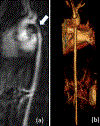Emergence of the natural history of Myhre syndrome: 47 patients evaluated in the Massachusetts General Hospital Myhre Syndrome Clinic (2016-2023)
- PMID: 38779990
- PMCID: PMC11586855
- DOI: 10.1002/ajmg.a.63638
Emergence of the natural history of Myhre syndrome: 47 patients evaluated in the Massachusetts General Hospital Myhre Syndrome Clinic (2016-2023)
Abstract
Myhre syndrome is an increasingly diagnosed ultrarare condition caused by recurrent germline autosomal dominant de novo variants in SMAD4. Detailed multispecialty evaluations performed at the Massachusetts General Hospital (MGH) Myhre Syndrome Clinic (2016-2023) and by collaborating specialists have facilitated deep phenotyping, genotyping and natural history analysis. Of 47 patients (four previously reported), most (81%) patients returned to MGH at least once. For patients followed for at least 5 years, symptom progression was observed in all. 55% were female and 9% were older than 18 years at diagnosis. Pathogenic variants in SMAD4 involved protein residues p.Ile500Val (49%), p.Ile500Thr (11%), p.Ile500Leu (2%), and p.Arg496Cys (38%). Individuals with the SMAD4 variant p.Arg496Cys were less likely to have hearing loss, growth restriction, and aortic hypoplasia than the other variant groups. Those with the p.Ile500Thr variant had moderate/severe aortic hypoplasia in three patients (60%), however, the small number (n = 5) prevented statistical comparison with the other variants. Two deaths reported in this cohort involved complex cardiovascular disease and airway stenosis, respectively. We provide a foundation for ongoing natural history studies and emphasize the need for evidence-based guidelines in anticipation of disease-specific therapies.
Keywords: SMAD4 variants; TGF‐β signaling; autism; connective tissue disease; hearing loss; vasculopathy.
© 2024 Wiley Periodicals LLC.
Figures





References
-
- Al Ageeli E, Mignot C, Afenjar A, Whalen S, Dorison N, Mayer M, Esteva B, Dubern B, Momtchilova M, Le Gargasson JF, Bursztyn J, & Héron D (2012). Retinal involvement in two unrelated patients with Myhre syndrome. European Journal of Medical Genetics, 55(10), 541–547. 10.1016/j.ejmg.2012.05.006 - DOI - PubMed
-
- Alagia M, Cappuccio G, Pinelli M, Torella A, Brunetti-Pierri R, Simonelli F, Limongelli G, Oppido G, Nigro V, Brunetti-Pierri N, & TUDP. (2018). A child with Myhre syndrome presenting with corectopia and tetralogy of Fallot. American Journal of Medical Genetics. Part A, 176(2), 426–430. 10.1002/ajmg.a.38560 - DOI - PMC - PubMed
-
- Alankarage D, Enriquez A, Steiner RD, Raggio C, Higgins M, Milnes D, Humphreys DT, Duncan EL, Sparrow DB, Giampietro PF, Chapman G, & Dunwoodie SL (2022). Myhre syndrome is caused by dominant-negative dysregulation of SMAD4 and other co-factors. Differentiation, 128, 1–12. 10.1016/j.diff.2022.09.002 - DOI - PMC - PubMed
MeSH terms
Substances
Supplementary concepts
Grants and funding
LinkOut - more resources
Full Text Sources
Miscellaneous

